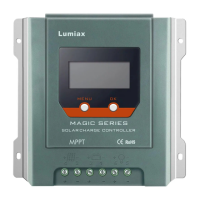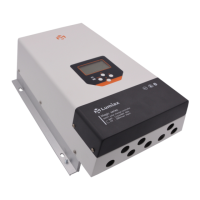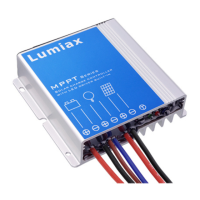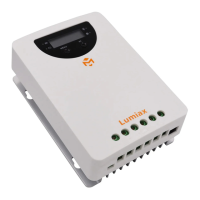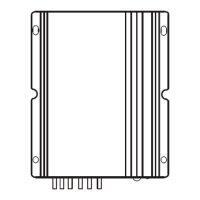An Advantage Over Traditional Controllers
Traditional PWM controllers connect the solar module directly to the battery when recharging. This
requires that the solar module operate in a voltage range that is usually below the module's Vmp. In a 12
Volt system for example, the battery voltage may range from 10.8-15 Vdc, but the module's Vmp is
typically around 16 or 17V.
Because traditional controllers do not always operate at the Vmp of the solar array, energy is wasted that
could otherwise be used to charge the battery and power system loads. The greater the difference
between battery voltage and the Vmp of the module, the more energy is wasted.
High Voltage Strings and Grid-Tie Modules
Another benefit of MPPT technology is the ability to charge batteries with solar arrays of higher nominal
voltages. For example, a 12 Volt battery bank may be charged with a 12-, 24-, 36-, or 48-Volt nominal off-
grid solar array. Grid-tie solar modules may also be used as long as the solar array open circuit voltage
(Voc) rating will not exceed the maximum input voltage rating at worst-case (coldest) module temperature.
The solar module documentation should provide Voc vs. temperature data.
Higher solar input voltage results in lower solar input current for a given input power. High voltage solar
input strings allow for smaller gauge solar wiring. This is especially helpful and economical for systems
with long wiring runs between the controller and the solar array.
P(W )
10 .8V
15 V
17 V
VP c urv e
0
I(A )
V(V )
MP P
10 .8V
15 V
17 V
Ty pic al
Ba tte ry
Vo lta ge
Ra nge
VI c urv e
0
V(V )
Px
Pmax -Px
MP P
PW M
Co ntr oller
Op era ting
Ra nge
Nominal 12 Volt Solar Module I-V cur ve and output power graph.
Contrast with the traditional PWM controller, MPPT controller could play a maximum power of the solar
panel so that a larger charging current could be supplied. Generally speaking, the controller's energy
utilization efficiency is 15%~20% higher than PWM controller.
Conditions That Limit the Effectiveness of MPPT
The Vmp of a solar module decreases as the temperature of the module increases. In very hot weather, the
Vmp may be close or even less than battery voltage. In this situation, there will be very little or no MPPT
gain compared to traditional controllers. However, systems with modules of higher nominal voltage than
the battery bank will always have an array Vmp greater than battery voltage. Additionally, the savings in
wiring due to reduced solar current make MPPT worthwhile even in hot climates.

